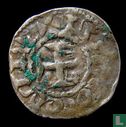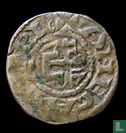

Enlarge image


Catalogue information
LastDodo number
7569717
Area
Coins
Title
Crusader Kingdom of Jerusalem 1 denier (Fulk of Anjou) 1131-1143
Country
Face value
Year
1140
Variety / overstrike
Head of State
Type
Designer
Series
Theme
Material
Gold- or silver content
Weight
0.5
Diameter
15
Thickness
Punch
Shape
Obverse
VRBS ANDECAVIS
Reverse
FVLCO COMES
Edge
Privy mark
Mint mark
Number produced
Krause and Mishler number
Catalogue number
Details
Fulk of Anjou became count of Anjou (as Fulk V) in 1109. He was originally an opponent of Henry I of England and a supporter of Louis VI of France, but in 1127 he allied with Henry when Henry arranged for his daughter Matilda to marry Fulk's son Geoffrey of Anjou.
Fulk went on crusade in 1120, and become a close friend of the Knights Templar. After his return he began to subsidize the Templars, and maintained two knights in the Holy Land for a year.By 1127 Fulk was preparing to return to Anjou when he received an embassy from King Baldwin II of Jerusalem.
Baldwin II had no male heirs but had already designated his daughter Melisende to succeed him. Baldwin II wanted to safeguard his daughter's inheritance by marring her to a powerful lord. Fulk was a wealthy crusader and experienced military commander, and a widower. His experience in the field would prove invaluable in a frontier state always in the grip of war.
Fulk and Melisende became joint rulers of Jerusalem in 1131 with Baldwin II's death. From the start Fulk assumed sole control of the government, excluding Melisende altogether. He favored fellow countrymen from Anjou to the native nobility. This led to resentment by the second generation of Jerusalem Christians who had grown up there since the First Crusade. These "natives" focused on Melisende's cousin, the popular Hugh II of Le Puiset, count of Jaffa, who was devotedly loyal to the Queen.
Fulk saw Hugh as a rival, and it did not help matters when Hugh's own step-son accused him of disloyalty. In 1134, in order to expose Hugh, Fulk accused him of infidelity with Melisende. Hugh rebelled in protest. Hugh secured himself to Jaffa, and allied himself with the Muslims of Ascalon. He was able to defeat the army set against him by Fulk, but this situation could not hold. The Patriarch interceded in the conflict, perhaps at the behest of Melisende. Fulk agreed to peace and Hugh was exiled from the kingdom for three years, a lenient sentence.
Jerusalem's northern border was of great concern. Fulk had been appointed regent of the Principality of Antioch by Baldwin II. As regent he had Raymund of Poitou marry the infant Constance of Antioch, daughter of Bohemund II and Alice of Antioch, and niece to Melisende. However, the greatest concern during Fulk's reign was the rise of Atabeg Zengi of Mosul.
In 1137 Fulk was defeated in battle near Barin but allied with the vizier of Damascus. Damascus was also threatened by Zengi. Fulk captured the fort of Banias, to the north of Lake Tiberiasand thus secured the northern frontier.
Fulk also strengthened the kingdom's southern border. His butler Paganus built the fortress of Kerak to the south of the Dead Sea, and to help give the kingdom access to the Red Sea, Fulk had Blanche Garde, Ibelin, and other forts built in the south-west to overpower the Egyptian fortress at Ascalon.
In 1137 and 1142, Byzantine emperor John II Comnenus arrived in Syria attempting to impose Byzantine control over the crusader states. John's arrival was ignored by Fulk, who declined an invitation to meet the emperor in Jerusalem.
In 1143, while the king and queen were on holiday in Acre, Fulk was killed in a hunting accident. His horse stumbled, fell, and Fulk's skull was crushed by the saddle. He was carried back to Acre, where he died on November 10th and was buried in the Church of the Holy Sepulchre. Though their marriage started in conflict, Melisende mourned for him privately as well as publicly. Fulk was survived by his son Geoffery of Anjou by his first wife, and Baldwin III and Amalric I by Melisende.
William of Tyre described Fulk as capable soldier and able politician, but observed that Fulk did not adequately attend to the defense of the crusader states to the north. The Zengids continued their march on the crusader states, culminating in the fall of the County of Edessa in 1144, which led to the Second Crusade.



